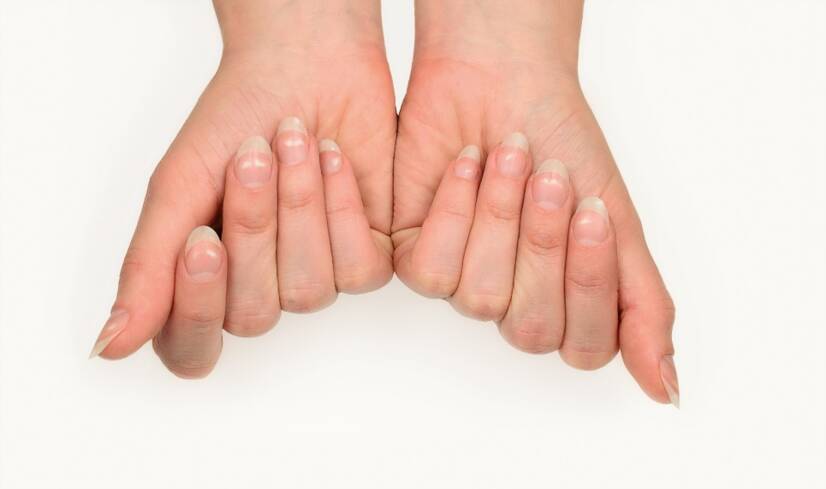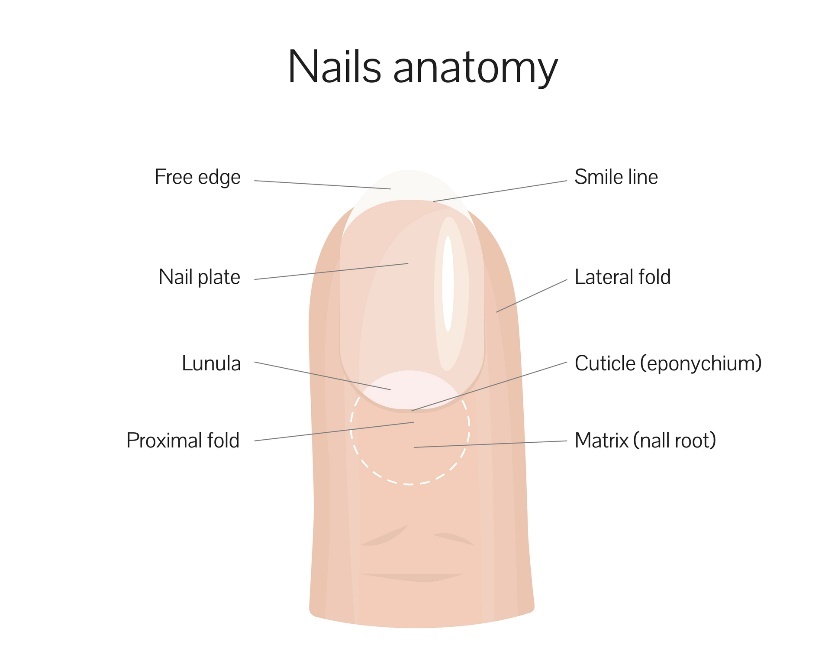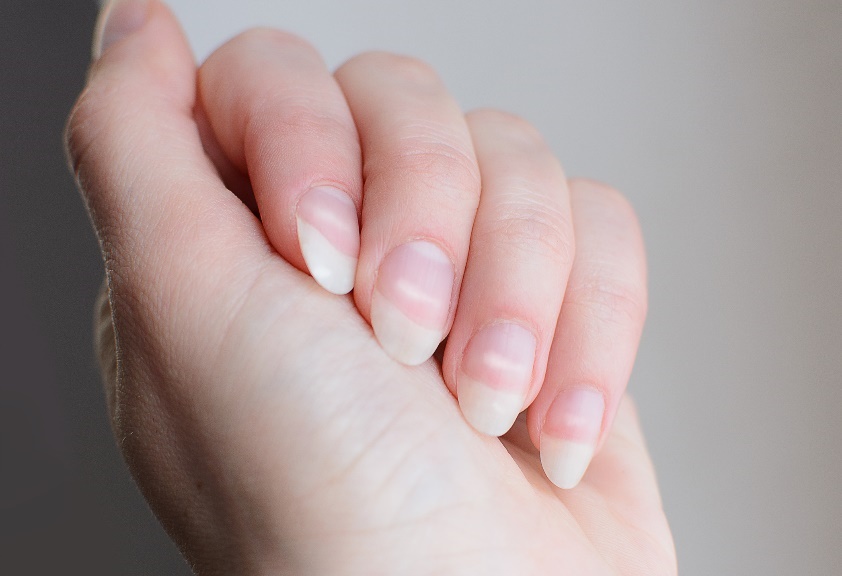- dermatologiepropraxi.cz - Diseases and pathologies of the nails. Dermatology for practice. MUDr. Alena Stumpfová
- solen.cz - Nail diseases. Solen. MUDr. Helena Korandová, CSc.
- healthline.com - Why Are There White Spots on My Nails? Healthline. Kimberly Holland
- medicalnewstoday.com - Reasons and treatments for white spots on the nails. Medical News Today. Tom Seymour
White spots on the nails: what do they mean and what are the causes?

A change in the shape, colour or texture of the nail can indicate damage, vitamin deficiencies or certain diseases. White spots on the nails are professionally called leukonychia. What do they signal and why do they occur?
A healthy human nail should have a soft pink color with a pale pink to white crescent at the root with a smooth surface.
The characteristics of leukonychia, possible causes, diagnosis, treatment and many other interesting information can be found in the article.
Nail health and function at a glance
A healthy nail consists of the nail matrix (the root of the nail), the lunula (the pale colored crescent), the cuticle (the nail cuticle), the nail bed and the nail plate.
The nail is the hard keratin plate covering the ends of the fingers and toes. The nail matrix is the part extending from the root of the nail bed to the lunula - the crescent. It is responsible for the formation and growth of the nail plate.
The nail bed lies below the nail plate layer and extends from the lunula to the very free edge of the nail. The bed below the nail plate is richly vascularized, which is why it is colored pink.
The function of the nail is to protect the ends of the links of the fingers, to enable the grasping of objects by counterpressure on the finger-bellies, and last but not least to serve as an auxiliary organ of the human tactile sense.

Human fingernails grow slowly. It takes at least 6 months for the entire length of the fingernail to grow back. Toenails grow even more slowly, with the entire length taking sometimes 12 to 18 months.
Unwanted grooves, stripes and other defects on the nails may indicate mechanical damage or disease that occurred recently or even months ago.
What is leukonychia?
Leukonychia is the technical name for the formation of white spots on the nail plate. Damage and keratinisation of the nail matrix results in visible white deposits, streaks, dots or spots on the nail plate. It is therefore a discolouration of the nail plate.
Leukonychia is divided into the true form and the false form, the so-called pseudoleukonychia.
True leukonychia is divided into total and partial (transverse and punctate) according to the extent of the changes. True leukonychia is caused by disorders of the nail matrix (root) from where the nail plate grows.
Under pressure, the white colour of the nail does not change and the colour shifts with the growth of the nail.
The transverse form with white streaks/lines is most often caused by mechanical damage, trauma, systemic disease, reactions to drugs and medications or various infections. The punctate form is mostly caused by mechanical micro-damage.
Partial leukonychia may be caused by minor injury during manicuring, sports, work or as a reaction to irritating nail cosmetic products and preparations.
The most common cause of white spots is an injury to the nail bed during nail growth. Air gets into the small, seemingly invisible wound, which can cause the white discoloration of the damaged part of the nail.
When the nail grows back, the white discoloration disappears at the same time.
Total leukonychia, in which all the nails are white, is a congenital disease or a manifestation of a serious disease/failure of the heart, lungs, liver, kidneys or intoxication of the body.
Pseudoleukonychia is caused by conditions in which the nail matrix is not responsible for the white spots on the nail plate. False leukonychia is mainly caused by abnormal light transmission at the affected part of the nail plate.
When pressure is applied, the white color on the nail disappears.
Examples are mycosis, onychomycosis, onychylosis or other fungal diseases of the nail bed.
A lack of necessary vitamins, minerals and proteins in the body is often given as the cause of white spots.

Etiology and possible causes
Mechanical damage to the nail
In most cases, small white spots on the nail do not indicate anything serious. Mechanical damage from even a mild stimulus is often the cause.
An inadequate manicure, microtrauma during a work activity, an accident during sports, knocking on a table or other weak stimuli.
In some cases, it can also be a reaction to artificial nails, nail polish or nail polish remover and other cosmetic products.
Since nail growth is relatively slow, the effect of a mechanical injury may not become apparent until several weeks have passed. The discoloured area will gradually grow back with the nail and fade away.
Lack of vitamins and minerals
Some sources state that the cause of white spots is precisely the lack of necessary nutrients in the body.
However, deficiencies of important substances are also manifested by increased brittleness, weak nails and poor hair quality or hair loss. In extreme cases, increased tooth decay and bone health problems.
As part of nail health, it is advisable to take care of the intake of zinc, selenium, iron and calcium.
Important are B vitamins, which have a positive effect on the health of the skin, nails and hair. Examples are riboflavin, biotin, folic acid and pantothenic acid.
It is advisable to include nuts, seeds, whole grains, legumes, vegetables and fruit in the diet. Last but not least, a sufficient daily intake of building substances - proteins - is needed.
Diseases and diagnoses
The causes of white spots can be serious in some cases. If white spots cover a large part of the nail plate or occur on several nails simultaneously, it is advisable to consult a dermatovenerologist for the etiology.
Medical problems that may cause white patches include liver cirrhosis, kidney disease, diabetes, anemia or thyroid disorder, among others.
A common reason for discoloration and change in nail texture is fungal disease or nail infection.
In extremely serious cases, this type of leukonychia can signal poisoning, intoxication, heart, liver, kidney and other internal organ disorders.
It may also be a side effect of sulfonamide treatment or a consequence of chemotherapy.
Diagnosis and treatment of leukonychia
The treatment of leukonychia depends on the aetiology and the exact cause. The area of the nails and surrounding area is dealt with by a dermatovenerologist (skin doctor).
On examination, the doctor may perform a biopsy (swab, scrape) of the nail for mycological analysis to determine the presence of infection.
It is advisable to take a blood sample from the patient and perform a laboratory blood test when a systemic disease is suspected. Liver tests, inflammatory values, thyroid hormones and other parameters examined.
If the white spot is the result of a mechanical injury, the spots will fade as the nail grows back. However, the nail grows slowly and generally regrows in 6 to 9 months.
To improve the quality of the nail, it is possible to use protective supportive topical medications or cosmetic supplements (nourishing ointment, protective varnish). However, consultation with a specialist/doctor is necessary.
If this is the result of a deficiency of vitamins, minerals or proteins in the body, it is necessary to adjust your diet and, if necessary, try proven nutritional supplements. In the context of nail and hair health, it is important to take in protein, zinc, selenium, vitamin B and vitamin C.
However, it is advisable to seek professional help and diagnosis from a dermatologist for any unclear symptoms.
Interesting resources










